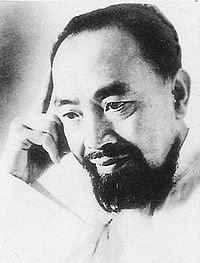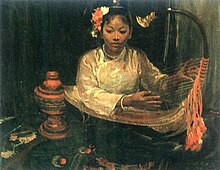| Situ Qiao 司徒乔 | |
|---|---|
 | |
| Born | Situ Qiaoxing 1902 Kaiping, Guangdong, China |
| Died | 16 February 1958 Beijing |
| Known for | Oil painting, graphic art |
| Notable work | Put Down Your Whip |
| Movement | Lingnan School |
| Spouse | Feng Yimei (冯伊湄) |
Situ Qiao (Chinese: 司徒乔; 1902 – 16 February 1958) was a Chinese oil painter and graphic artist. An important member of the Lingnan School of art, he was also known for his friendship with the influential writer Lu Xun. His most famous work is the 1940 painting Put Down Your Whip.
Biography

Situ Qiao was born to a poor family in Chikan, Kaiping, Guangdong province in 1902. His name at birth was Situ Qiaoxing (司徒乔兴). His father was an amateur painter.
In 1924, Situ entered the School of Theology of Yenching University in Beijing, but was more interested in painting. In 1926, he held his first personal exhibition, which was noticed by Lu Xun, who purchased his drawing Five Policemen and an O. When the Northern Expedition war erupted in 1927, he moved to Wuhan to work for the Soviet advisor Mikhail Borodin.
By 1928, he had moved to Shanghai and set up a studio. He held an exhibition in March 1928, which was again noticed by Lu Xun, who wrote about his conversation with Situ Qiao. In winter 1928, Situ left for France to study painting, and exhibited at the Paris Salon the following year.
In 1930, Situ Qiao left France to study in New York City. He supported his studies by selling his own paintings. However, his activity was considered working, which was illegal for a holder of a student visa, and he was arrested. While being held in a prison for immigrants, he painted a painting entitled Painting the Statue of Liberty from the Most Unfree Place.
After being deported back to China, in 1931 he taught at Lingnan University in Guangzhou. In 1934, he went to Beijing, working as an art editor for Ta Kung Pao, and moved to Shanghai in 1936. Situ Qiao was present when Lu Xun died on 19 October 1936 in Shanghai, and drew the famous final sketches of the writer.
He soon moved to Nanjing, then capital of China. When the invading Japanese army attacked Nanjing in 1937, all his personal collection of paintings were destroyed.

Fleeing from the Sino-Japanese War, Situ Qiao left China for Rangoon, Burma, and later to Singapore. In 1940, he saw actor Jin Shan and actress Wang Ying's performance of Chen Liting's patriotic play Put Down Your Whip. He invited Jin Shan and Wang Ying to his studio, and painted his eponymous oil painting, which has become his most famous work.
When Singapore also fell to the Japanese in 1941, Situ Qiao escaped to the wartime Chinese capital Chongqing. After WWII, Situ Qiao went to New York City with his wife, Feng Yimei in September 1946 to seek treatment for his lung disease. They returned to Beijing in 1950 after the founding of the People's Republic of China. He taught at the China Central Academy of Fine Arts and helped to set up the Museum of the Chinese Revolution.
On 16 February 1958, Situ Qiao died in his studio in Beijing. He donated all his paintings to the state, which are now in the collections of various museums in Beijing, Shanghai, Guangzhou, and his hometown, Kaiping. A compilation of his paintings was published by Beijing People's Art Publishing House.
References
- ^ Sullivan, Michael (2006). Modern Chinese Artists: A Biographical Dictionary. University of California Press. p. 140. ISBN 9780520244498.
- "Commemorate 110th Anniversary of Situ Qiao". Government of Guangzhou. Archived from the original on 2013-10-21. Retrieved 2013-10-20.
- ^ 司徒乔 《古琴图》 [Situ Qiao's Guqin] (in Chinese). Xinhua. Archived from the original on 15 November 2013. Retrieved 20 October 2013.
- ^ 司徒乔 [Situ Qiao] (in Chinese). China Central Academy of Fine Arts. Retrieved 20 October 2013.
- 油画《放下你的鞭子》 [Oil Painting Put Down Your Whip] (in Chinese). Xinhua. 17 June 2005. Archived from the original on 14 November 2013. Retrieved 21 October 2013.
- ^ 司徒乔 [Situ Qiao] (in Chinese). Chinese Culture and Art Network. 20 May 2011. Retrieved 3 November 2013.
Further reading
- Appreciating Situ Qiao's Paintings: Lu Xun's reflection on his conversation with Situ Qiao (1928). (in Chinese)
- The Situ Qiao I Knew: writer Shen Congwen's memoir of Situ Qiao (1980). (in Chinese)
- Situ Qiao: an Unfinished Painting: a biography by the painter's wife Feng Yimei, first published in Hong Kong in 1976. (in Chinese)
- 1902 births
- 1958 deaths
- People from Kaiping
- 20th-century Chinese painters
- Painters from Guangdong
- Academic staff of the Central Academy of Fine Arts
- Academic staff of Lingnan University (Guangzhou)
- Yenching University alumni
- Chinese art educators
- People deported from the United States
- Chinese expatriates in France
- Chinese expatriates in the United States
- Educators from Guangdong
- Singaporean people of Cantonese descent